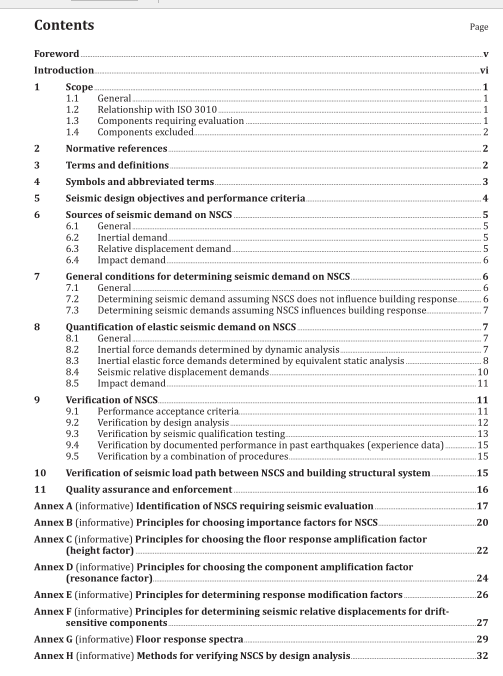BS ISO 13033:2013 pdf download.Bases for design of structures — Loads, forces and other actions — Seismic actions on nonstructural components for building applications
This International Standard establishes the means to derive seismic actions on nonstructural components and systems (NSCS) supported by or attached to new or existing buildings. It also provides procedures for the verification of NSCS seismic capacities. NSCS include architectural elements, mechanical and electrical systems, and building contents.
This International Standard is not a legally binding and enforceable code. It is a source document that is utilized in the development of codes of practice by the competent authority responsible for issuing structural design regulations. This International Standard is intended for application by regional and national standards committees when preparing standards for the seismic performance of NSCS. This International Standard does not specifically cover industrial facilities, including nuclear power plants, since these are dealt with separately in other International Standards. However, the principles in this International Standard can be appropriate for the derivation of seismic actions for NSCS in such facilities.
NOTE 1 This International Standard has been prepared mainly for NSCS associated with engineered buildings. The principles are, however, applicable to non-engineered buildings.
NOTE 2 Procedures for the verification of the supporting building structure for gravity and seismic actions applied by the NSCS are outside the scope of this International Standard and are provided in ISO 3010.
1.2 Relationship with ISO 3010 This International Standard is a companion document to ISO 3010, Basis for design of structures
— Seismic actions on structures. ISO 3010 and its annexes provide basic seismic design criteria to be used in the design of structures but they do not provide design criteria for NSCS (except for those that can influence the structural response). For consistency, the terms and definitions that are in common with ISO 3010 are also used in this International Standard.
The same ground motion criteria specified in ISO 3010 are also used in this International Standard. The demand on NSCS is directly related to the response of the building in which they are located. Therefore, the procedures used to determine the design ground motion and building seismic response are directly referenced by this International Standard.
1.3 Components requiring evaluation Evaluation of NSCS for seismic actions is required where any of the following apply:
a) the NSCS poses a falling hazard;
b) the failure of the NSCS can impede the evacuation of the building;
c) the NSCS contains hazardous materials;
d) the NSCS is necessary to the continuing function of essential facilities after the event; and
e) damage to the NSCS represents a significant financial loss.
Guidance for identification of NSCS that require seismic evaluation is provided in Annex A.
NOTE Pre-assembled modular mechanical and electrical units (e.g. heating and cooling modules) may be treated as an assembly of components supported by the modular unit housing structure (see 9.5).
1.4 Components excluded
The requirements of this International Standard are not intended for application to furnishings, or temporary or relocatable components (see Annex A).
With the exception of parapets (as described in Annex A), application of this International Standard to components in buildings subject to low levels of seismic hazard may not be warranted.
2 Normative references
The following documents, in whole or in part, are normatively referenced in this document and are indispensable for its application. For dated references, only the edition cited applies. For undated references, the latest edition of the referenced document (including any amendments) applies.
ISO 3010:2001, Basis for design of structures — Seismic actions on structures
3 Terms and definitions
For the purposes of this document, the terms and definitions given in ISO 3010 and the following apply.
3.1 ductility
ability to deform beyond the elastic limit under cyclic loading without significant reduction in strength or energy absorption capacity
3.2 interstorey drift
lateral displacement within a storey
3.3 moderate earthquake ground motion
moderate ground motion caused by earthquakes which can be expected to occur during the service life of the building.BS ISO 13033 pdf download.ISO 13033-2013 pdf download
